Students can Download Physics Chapter 10 Communication Systems Questions and Answers, Notes Pdf, Samacheer Kalvi 12th Physics Solutions Guide Pdf helps you to revise the complete Tamilnadu State Board New Syllabus and score more marks in your examinations.
Tamilnadu Samacheer Kalvi 12th Physics Solutions Chapter 10 Communication Systems
Samacheer Kalvi 12th Physics Communication Systems Textual Evaluation Solved
Samacheer Kalvi 12th Physics Communication Systems Multiple Choice Questions
Question 1.
The output transducer of the communication system converts the radio signal into …………. .
(a) Sound
(b) Mechanical energy
(c) Kinetic energy
(d) None of the above
Answer:
(a) Sound.
Question 2.
The signal is affected by noise in a communication system …………. .
(a) At the transmitter
(b) At the modulator
(c) In the channel
(d) At the receiver
Answer:
(c) In the channel.
![]()
Question 3.
The variation of frequency of carrier wave with respect to the amplitude of the modulating signal is called …………. .
(a) Amplitude modulation
(b) Frequency modulation
(c) Phase modulation
(d) Pulse width modulation
Answer:
(b) Frequency modulation.
Question 4.
The internationally accepted frequency deviation for the purpose of FM broadcasts …………. .
(a) 75 kHz
(h) 68 kHz
(c) 80 kHz
(d) 70 kHz
Answer:
(a) 75 kHz.
Question 5.
The frequency range of 3 MHz to 30 MHz is used for …………. .
(a) Ground wave propagation
(b) Space wave propagation
(c) Sky wave propagation
(d) Satellite communication
Answer:
(c) Sky wave propagation.
Samacheer Kalvi 12th Physics Communication Systems Short Answer Questions
Question 1.
Give the factors that are responsible for transmission impairments.
Answer:
- Attenuation
- Distortion (Harmonic)
- Noise
Question 2.
Distinguish between wireline and wireless communication? Specify the range of electromagnetic waves in which it is used.
Answer:
| Wireline communication | Wireless communication |
| It is a point-to-point communication. |
It is a broadcast mode communication. |
| It uses mediums like wires, cable and optical fibres. | It uses free space as a communication medium. |
| These systems cannot be used for long distance transmission as they are connected. | These systems can be used for long distance transmission. |
| Ex: telephone, intercom and cable TV. |
Ex: mobile, radio or TV broadcasting and satellite communication. |
Question 3.
Explain centre frequency or resting frequency in frequency modulation.
Answer:
When the frequency of the baseband signal is zero (no input signal), there is no change in the frequency of the carrier wave. It is at its normal frequency and is called as centre frequency or resting frequency.
Question 4.
What does RADAR stand for?
Answer:
Radar basically stands for Radio Detection and Ranging System.
![]()
Question 5.
What do you mean by Internet of Things?
Answer:
Internet of Things (IoT), it is made possible to control various devices from a single device. Example: home automation using a mobile phone.
Samacheer Kalvi 12th Physics Communication Systems Long Answer Questions
Question 1.
What is modulation? Explain the types of modulation with necessary diagrams.
Answer:
Modulation:
For long distance transmission, the low frequency baseband signal (input signal) is superimposed onto a high frequency radio signal by a process called modulation. There are 3 types of modulation based on which parameter is modified. They are (i) Amplitude modulation, (ii) Frequency modulation, and (iii) Phase modulation.
(i) Amplitude Modulation (AM):
If the amplitude of the carrier signal is modified according to the instantaneous amplitude of the baseband signal, then it is called amplitude modulation. Here the frequency and the phase of the carrier signal remain constant. Amplitude modulation is used in radio and TV broadcasting.
The signal shown in figure (a) is the message signal or baseband signal that carries information, figure (b) shows the high frequency carrier signal and figure (c) gives the amplitude modulated signal. We can see clearly that the carrier wave is modified in proportion to the amplitude of the baseband signal
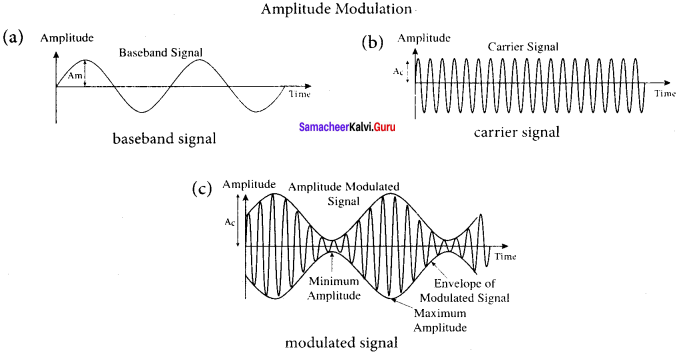
(ii) Frequency Modulation (FM):
The frequency of the carrier signal is modified according to the instantaneous amplitude of the baseband signal in frequency modulation. Here the amplitude and the phase of the carrier signal remain constant. Increase in the amplitude of the baseband signal increases the frequency of the carrier signal and vice versa. This leads to compressions and rarefactions in the frequency spectrum of the modulated wave. Louder signal leads to compressions and relatively weaker signals to rarefactions.
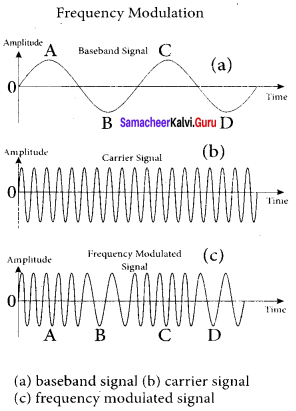
When the amplitude of the baseband signal is zero in Figure (a), the frequency of the modulated signal is the same as the carrier signal. The frequency of the modulated wave increases when the amplitude of the baseband signal increases in the positive direction (A,C). The increase in amplitude in the negative half cycle (B,D) reduces the frequency of the modulated wave (Figure (c)).
(iii) Phase Modulation (PM)
The instantaneous amplitude of the baseband signal modifies the phase of the carrier signal keeping the amplitude and frequency constant is called phase modulation. This modulation is used to generate frequency modulated signals. It is similar to frequency modulation except that the phase of the carrier is varied instead of varying frequency.
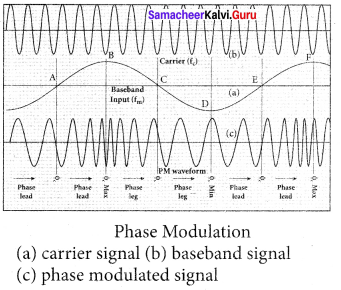
The carrier phase changes according to increase or decrease in the amplitude of the baseband signal. When the modulating signal goes positive, the amount of phase lead increases with the amplitude of the modulating signal. Due to this, the carrier signal is compressed or its frequency is increased.
On the other hand, the negative half cycle of the baseband signal produces a phase lag in the carrier signal. This appears to have stretched the frequency of the carrier wave. Hence similar to frequency modulated wave, phase modulated wave also comprises of compressions and rarefactions. When the signal voltage is zero (A, C and E) the carrier frequency is unchanged.
![]()
Question 2.
Elaborate on the basic elements of communication system with the necessary block diagram.
Elements of an electronic communication system:
1. Information (Baseband or input signal):
Information can be in the form of a sound signal like speech, music, pictures, or computer data Information can be in the form of a sound signal like speech, music, pictures, or computer data which is given as input to the input transducer.
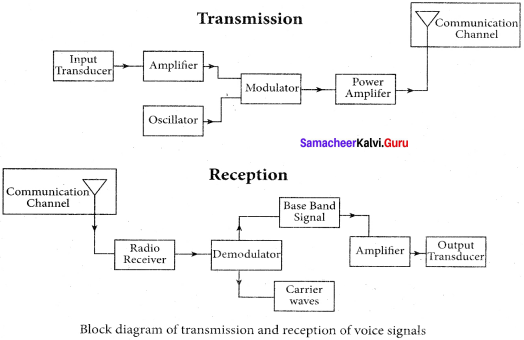
2. Input transducer:
A transducer is a device that converts variations in a physical quantity (pressure, temperature, sound) into an equivalent electrical signal or vice versa. In communication system, the transducer converts the information which is in the form of sound, music, pictures or computer data into corresponding electrical signals. The electrical equivalent of the original information is called the baseband signal. The best example for the transducer is the microphone that converts sound energy into electrical energy.
3. Transmitter:
It feeds the electrical signal from the transducer to the communication channel. It consists of circuits such as amplifier, oscillator, modulator, and power amplifier. The transmitter is located at the broadcasting station.
4. Amplifier:
The transducer output is very weak and is amplified by the amplifier.
5. Oscillator:
It generates high-frequency carrier wave (a sinusoidal wave) for long distance transmission into space. As the energy of a wave is proportional to its frequency, the carrier wave has very high energy.
6. Modulator:
It superimposes the baseband signal onto the carrier signal and generates the modulated signal.
7. Power amplifier:
It increases the power level of the electrical signal in order to cover a large distance.
8. Transmitting antenna:
It radiates the radio signal into space in all directions. It travels in the form of electromagnetic waves with the velocity of light (3 x 108 ms-1).
9. Communication channel:
Communication channel is used to carry the electrical signal from transmitter to receiver with less noise or distortion. The communication medium is basically of two types: wireline communication and wireless communication.
10. Noise:
It is the undesirable electrical signal that interfaces with the transmitted signal. Noise attenuates or reduces the quality of the transmitted signal. It may be man-made (automobiles, welding machines, electric motors etc .) or natural (lightening, radiation from sun and stars and environmental effects). Noise cannot be completely eliminated. However, it can be reduced using various techniques.
11. Receiver:
The signals that are transmitted through the communication medium are received with the help of a receiving antenna and are fed into the receiver. The receiver consists of electronic circuits like demodulator, amplifier, detector etc. The demodulator extracts the baseband signal from the carrier signal. Then the baseband signal is detected and amplified using amplifiers. Finally, it is fed to the output transducer.
12. Repeaters:
Repeaters are used to increase the range or distance through which the signals are sent. It is a combination of transmitter and receiver. The signals are received, amplified, and retransmitted with a carrier signal of different frequency to the destination. The best example is the communication satellite in space.
13. Output transducer:
It converts the electrical signal back to its original form such as sound, music, pictures or data. Examples of output transducers are loudspeakers, picture tubes, computer monitor, etc.
14. Attenuation:
The loss of strength of a signal while propagating through a medium is known as attenuation. Range It is the maximum distance between the source and the destination up to which the signal is received with sufficient strength.
![]()
Question 3.
Explain the three modes of propagation of electromagnetic waves through space. Propagation of electromagnetic waves:
Answer:
The electromagnetic wave transmitted by the transmitter travels in three different modes to reach the receiver according to its frequency range:
- Ground wave propagation (or) surface wave propagation (nearly 2 kHz to 2 MHz)
- Sky wave propagation (or) ionospheric propagation (nearly 3 MHz to 30 MHz)
- Space wave propagation (nearly 30 MHz to 400 GHz)
1. Ground wave propagation:
If the electromagnetic waves transmitted by the transmitter glide over the surface of the earth to reach the receiver, then the propagation is called ground wave propagation. The corresponding waves are called ground waves or surface waves.
Both transmitting and receiving antennas must be close to the earth. The size of the antenna plays a major role in deciding the efficiency of the radiation of signals. During transmission, the electrical signals are attenuated over a distance. Some reasons for attenuation are as follows:
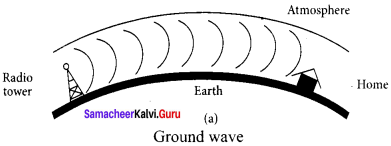
1. Increasing distance:
The attenuation of the signal depends on (i) power of the transmitter (ii) frequency of the transmitter, and (iii) condition of the earth surface.
2. Absorption of energy by the Earth:
When the transmitted signal in the form of EM wave is in contact with the Earth, it induces charges in the Earth and constitutes a current. Due to this, the earth behaves like a leaky capacitor which leads to the attenuation of the wave.
3. Tilting of the wave:
As the wave progresses, the wavefront starts gradually tilting according to the Skywave curvature of the Earth. This increase in the tilt decreases the electric field strength of the wave. Finally, at some distance, the surface wave dies out due to energy loss.
The frequency of the ground waves is mostly less than 2 MHz as high frequency waves undergo more absorption of energy at the earth’s atmosphere. The medium wave signals received during the day time use surface wave propagation. It is mainly used in local broadcasting, radio navigation, for ship-to-ship, ship-to-shore communication and mobile communication.
2. Sky Wave Propagation:
The mode of propagation in which the electromagnetic waves radiated from an antenna, directed upwards at large angles gets reflected by the ionosphere back to earth is called sky wave propagation or ionospheric propagation. The corresponding waves are called sky waves.
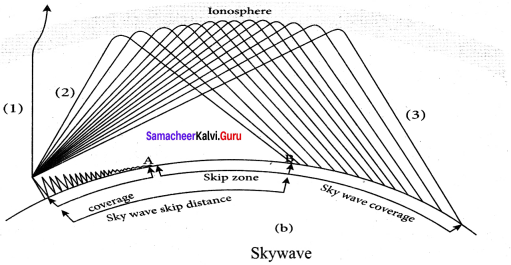
The frequency range of EM waves in this mode of propagation is 3 to 30 MHz. EM waves of frequency more than 30 MHz can easily penetrate through the ionosphere and does not undergo reflection. It is used for short wave broadcast services. Medium and high frequencies are for long-distance radio communication.
Extremely long distance communication is also possible as the radio waves can undergo multiple reflections between the earth and the ionosphere. A single reflection helps the radio waves to travel a distance of approximately 4000 km.
Ionosphere acts as a reflecting surface. It is at a distance of approximately 50 km and spreads up to 400 km above the Earth surface. Due to the absorption of ultraviolet rays, cosmic ray, and other high energy radiations like a, p rays from sun, the air molecules in the ionosphere get ionized.
This produces charged ions and these ions provide a reflecting medium for the reflection of radio waves or communication waves back to earth within the permitted frequency range. The phenomenon of bending the radio waves back to earth is nothing but the total internal reflection.
3. Space wave propagation:
The process of sending and receiving information signal through space is called space wave communication. The electromagnetic waves of very high frequencies above 30 MHz are called as space waves. These waves travel in a straight line from the transmitter to the receiver. Hence, it is used for a line of sight communication (LOS).
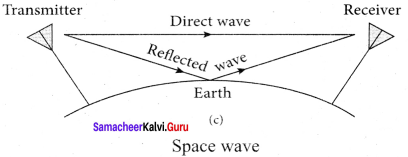
For high frequencies, the transmission towers must be high enough so that the transmitted and received signals (direct waves) will not encounter the curvature of the earth and hence travel with less attenuation and loss of signal strength. Certain waves reach the receiver after getting reflected from the ground.
Question 4.
What do you know about GPS? Write a few applications of GPS.
Answer:
GPS stands for Global Positioning System. It is a global navigation satellite system that offers geolocation and time information to a GPS receiver anywhere on or near the Earth. GPS system works with the assistance of a satellite network. Each of these satellites broadcasts a precise signal like an ordinary radio signal.
These signals that convey the location data are received by a low-cost aerial which is then translated by the GPS software. The software is able to recognize the satellite, its location, and the time taken by the signals to travel from each satellite. The software then processes the data it accepts from each satellite to estimate the location of the receiver.
Applications:
Global positioning system is highly useful many fields such as fleet vehicle management (for tracking cars, trucks and buses), wildlife management (for counting of wild animals) and engineering (for making tunnels, bridges etc).
![]()
Question 5.
Give the applications of ICT in mining and agriculture sectors.
Answer:
(i) Agriculture:
The implementation of information and communication technology (ICT) in agriculture sector enhances the productivity, improves the living standards of farmers and overcomes the challenges and risk factors.
(a) ICT is widely used in increasing food productivity and farm management.
(b) It helps to optimize the use of water, seeds and fertilizers etc.
(c) Sophisticated technologies that include robots, temperature and moisture sensors, aerial images, and GPS technology can be used.
(d) Geographic information systems are extensively used in farming to decide the suitable place for the species to be planted.
(ii) Mining:
(a) ICT in mining improves operational efficiency, remote monitoring and disaster locating system.
(b) Information and communication technology provides audio-visual warning to the trapped underground miners.
(c) It helps to connect remote sites.
Question 6.
Modulation helps to reduce the antenna size in wireless communication – Explain. Antenna size:
Answer:
Antenna is used at both transmitter and receiver end. Antenna height is an important parameter to be discussed. The height of
the antenna must be a multiple of \(\frac { λ }{ 4 }\),
h = \(\frac { λ }{ 4 }\) ….. (1)
where λ is wavelength ( λ = \(\frac { c}{ v }\)), c is the velocity of light and v is the frequency of the signal to be transmitted.
An example:
Let us consider two baseband signals. One signal is modulated and the other is not modulated. The frequency of the original baseband signal is taken as v = 10 kHz while the modulated signal is v = 1 MHz. The height of the antenna required to transmit the original baseband signal of frequency v = 10 kHz is
h1 = \(\frac { λ }{ 4 }\) = \(\frac { c }{ 4v }\) = \(\frac { 3\times { 10 }^{ 8 } }{ 4\times 10\times { 10 }^{ 3 } } \) = 7.5 km …. (2)
The height of the antenna required to transmit the modulated signal of frequency v = 10 kHz is
h1 = \(\frac { λ }{ 4 }\) = \(\frac { c }{ 4v }\) = \(\frac { 3\times { 10 }^{ 8 } }{ 4\times 10\times { 10 }^{ 6 } } \) = 75 m …. (3)
Comparing equations (2) and (3), we can infer that it is practically feasible to construct an antenna of height 75 m while the one with 7.5 km is not possible. It clearly manifests that modulated signals reduce the antenna height and are required for long distance transmission.
![]()
Question 7.
Fiber optic communication is gaining popularity among the various transmission media -justify.
Answer:
The method of transmitting information from one place to another in terms of light pulses through an optical fiber is called fiber optic communication. It is in the process of replacing wire transmission in communication systems. Light has very high frequency (400 THz – 790 THz) than microwave radio systems. The fibers are made up of silica glass or silicon dioxide which is highly abundant on Earth.
Now it has been replaced with materials such as chalcogenide glasses, fluoroaluminate crystalline materials because they provide larger infrared wavelength and better transmission capability. As fibers are not electrically conductive, it is preferred in places where multiple channels are to be laid and isolation is required from electrical and electromagnetic interference.
Applications:
Optical fiber system has a number of applications namely, international communication, inter-city communication, data links, plant and traffic control and defense applications.
Merits:
- Fiber cables are very thin and weight lesser than copper cables.
- This system has much larger bandwidth. This means that its information canying capacity is larger.
- Fiber optic system is immune to electrical interferences.
- Fiber optic cables are cheaper than copper cables.
Demerits:
- Fiber optic cables are more fragile when compared to copper wires.
- It is an expensive technology.
Samacheer Kalvi 12th Physics Communication Systems Additional Questions
Samacheer Kalvi 12th Physics Communication Systems Multiple Choice Questions
Question 1.
Which of the following frequencies will be suitable for beyond the horizon communication using sky waves?
(a) 10 kHz
(b) 10 MHz
(c) 1 GHz
(d) 1000 GHz
Answer:
(b) 10 MHz
Hint:
Frequency of 10 KHz will require very large radiating antenna while frequencies 1GHz and 1000 GHz will penetrate the ionosphere and cannot be reflected by it.
Question 2.
Frequency in the UHF range normally propagate by means of:
(a) Ground waves
(b) sky waves
(c) surface waves
(d) space waves
Answer:
(d) space waves.
Hint:
Frequency in the UHF (0.3 to 3 GHz) range normally propagate by means of space waves. Their sky wave reflection from ionosphere is not possible.
![]()
Question 3.
Antenna is
(a) inductive
(b) capacitive
(c) resistive above its resonant frequency
(d) resistive at resonant frequency
Answer:
(d) resistive at resonant frequency.
Hint:
An antenna is tuned circuit consisting of an inductance and a capacitance. At resonant frequency, it is resistive.
Question 4.
In frequency modulated wave
(a) frequency varies with time
(b) amplitude varies with time
(c) both frequency and amplitude vary with time
(d) both frequency and amplitude are constant
Answer:
(a) frequency varies with time.
Hint:
In frequency modulated wave, frequency of the carrier wave varies in accordance with the modulating signal.
Question 5.
Laser light is considered to be coherent because it consist of
(a) many wavelengths
(b) uncoordinated wavelengths
(c) coordinated waves of exactly the same wavelength
(d) divergent beam
Answer:
(c) coordinated waves of exactly the same wavelength
Hint:
Laser light consists of waves of save wavelength exactly in same phase. So it is highly coherent.
![]()
Question 6.
The waves used by artificial satellites for communication purposes are
(a) microwaves
(b) AM radiowaves
(c) FM radiowaves
(d) X-rays
Answer:
(a) microwaves
Hint:
Microwaves are used in artificial satellites for communication purposes.
Question 7.
An oscillator is producing FM waves of frequency 2 kHz with a variation of 10 kHz. What is the modulation index?
(a) 0.67
(b) 5.00
(c) 0.20
(d) 1.5
Answer:
(b) 5.00
Hint:
mf = \(\frac { ∆f }{ f }\) = \(\frac { 10kHz }{ 2kHz }\) = 5
Question 8.
A laser beam is used for locating distant object because it
(a) has small angular spread
(b) is not absorbed
(c) is coherent
(d) is monochromatic
Answer:
(a) has small angular spread
Hint:
Laser beam has very small angular spread.
Question 9.
In short wave communication, waves of which of the following frequencies will be reflected back by the ionospheric layer having electron density 1011 m-3?
(a) 2 MHz
(b) 10 MHz
(c) 12 MHz
(d) 18 MHz
Answer:
(a) 2 MHz
Hint:
Critical frequency, fc = 9 (Nmax)1/2
= 9(1011)1/2 = 2.8 x 106 Hz = 2.8 MHz
∴ The wave of frequency 2 MHz will be reflected by the ionosphere.
Question 10.
The maximum distance upto which TV transmission from a TV tower of height h can be received is proportional to
(a) h1/2
(b) h
(c) 3/2
(d) h2
Answer:
(a) h1/2
Hint:
d = \(\sqrt { 2Rh } \) ; d ∝ h1/2
![]()
Question 11.
If the highest modulating frequency of the wave is 5 kHz, the number of stations that can be accommodated in a 150 kHz band width is
(a) 15
(b) 10
(c) 5
(d) none of these
Answer:
(a) 15
 = \(\frac { 150khz }{ 2×5kHz }\) = 15
= \(\frac { 150khz }{ 2×5kHz }\) = 15
Question 12.
In communication with help of antenna if height is doubled, then the range covered with which was initially r would become
(a) \(\sqrt { 2r } \)
(b) 3r
(c) 4r
(d) 5r
Answer:
(a) \(\sqrt { 2r } \)
Hint:
Initial range, r – \(\sqrt { 2Rh } \)
When height of antenna is doubled, r’ = \(\sqrt { 2R\times 2h } \) – \(\sqrt { 2r } \)
Question 13.
A laser beam is used for carrying out surgery, because it
(a) is highly monochromatic
(b) is highly coherent
(e) is highly directional
(d) can be sharply focused
Answer:
(d) can be sharply focused
Hint:
A laser beam is highly monochromatic, directional and coherent and hence it can be sharply focused for carrying out surgery.
Question 14.
Ozone layer is present in
(a) troposphere
(b) stratosphere
(c) ionosphere
(d) mesosphere
Answer:
(b) stratosphere
Question 15.
Ozone layer blocks the radiation of wavelength
(a) less than 3 x 10-7 m
(b) equal to 3 x 10-7 m
(c) more than 3 x 10-7 m
(d) none of these
Answer:
(a) less than 3 x 10-7 m
Hint:
Ozone layer blocks ultraviolet radiation from the sun for this radiation λ < 3 x 10-7 m.
![]()
Question 16.
What is the cause of Green house effect?
(a) Infrared rays
(b) ultraviolet rays
(c) X-rays
(d) radiowaves
Answer:
(a) Infrared rays
Question 17.
Ozone layer in atmosphere is useful, because it
(a) stops ultraviolet radiation
(b) stops green house effect
(c) stops increase in temperature of atmosphere
(d) absorbs pollutent gases
Answer:
(a) stops ultraviolet radiation
Question 18.
Biological importance of ozone layer is
(a) ozone layer controls O2 / H2 ratio in atmosphere
(b) it stops ultraviolet rays
(c ) ozone layer reduces green house
(d) ozone layer reflects radio waves
Answer:
(b) it stops ultraviolet rays
Hint:
Ozone layer stops ultraviolet radiation.
Question 19.
The principle used in the transmission of signals through an optical fibre is
(a) total internal reflection
(b) refraction
(c) dispersion
(d) interference
Answer:
(a) total internal reflection
Hint:
Signals propagate through an optical fibre by suffering repeated total internal reflections.
Question 20.
LANDSAT series of satellites move in near polar orbits at an altitude of
(a) 3600 km
(b) 3000 km
(c) 918 km
(d) 512 km
Answer:
(c) 918 km
Hint:
LANDSAT satellites are polar satellites which move in polar orbit at a height of 918 km above the surface of the earth.
![]()
Question 21.
Which of the following is not a transducer?
(a) loudspeaker
(b) amplifier
(c) microphone
(d) all of these
Answer:
(b) amplifier
Hint:
Any device which converts energy from one form to another is called a transducer. Loudspeaker and microphone are transducers but not an amplifier.
Question 22.
If a radio receiver amplifies all the signal frequencies equally well, it is said to have high
(a) fidelity
(b) distortion
(c) sensitivity
(d) selectivity
Answer:
(a) fidelity
Hint:
If a radio receiver amplifies all the signal frequencies equally well, it is said to have high fidelity.
Question 23.
The sky wave propagation is suitable for radio waves of frequency
(a) from 2 MHz to 50
(b) upto 2MHz
(c) from 2 MHz to 30 MHz
(d) from 2MHz to 20 MHz
Answer:
(c) from 2 MHz to 30 MHz
Question 24.
Refractive index of ionosphere is
(a) zero
(b) more than one
(c) less than one
(d) one
Answer:
(c) less than one
Hint:
Ionosphere is the upper most layer of earth’s atmosphere having veiy low density. Its refractive index is less than one.
Question 25.
When radiowaves pass through ionosphere phase difference between space current and capacitive displacement current is
(a) 0 rad
(b) 3π/2 rad
(c) π/2 rad
(d) π rad
Answer:
(a) 0 rad
Hint:
The phase difference between space current and capacitive displacement current is zero.
![]()
Question 26.
Advantages of optical fibres are
(a) high bandwidth and EM interference
(b) low bandwidth and EM interference
(c) high bandwidth, low transmission capacity and no EM interference
(d) high bandwidth, high data transmission capacity and no EM interference
Answer:
(d) high bandwidth, high data transmission capacity and no EM interference
Hint:
Optical fibres have high bandwidth, high data transmission capacity and are free from electromagnetic interference.
Question 27.
A TV tower has a height of 100 m. What is the maximum distance upto which the TV transmission can be received? R = 8 x 106 m
(a) 34.77 km
(b) 32.70 km
(c) 40 km
(d) 40.70 km
Answer:
(c) 40 km
Hint:
d = \(\sqrt { 2hr } \) = \(\sqrt { 2\times 100\times 8\times { 10 }^{ 6 } } \) = 40,000 m = 40 km
Question 28.
Modem is a device which performs
(a) modulation
(b) demodulation
(c) rectification
(d) modulation and demodulation
Answer:
(d) modulation and demodulation
Question 29.
Which of the following device is full duplex?
(a) Mobile phone
(b) walky-talky
(c) loud-speaker
(d) radio
Answer:
(a) Mobile phone
Hint:
A mobile phone is a full duplex device by which two persons can talk and hear each other at the same time.
![]()
Question 30.
For a radio signal to travel 150 km from the transmitter to a receiving antenna, it takes
(a) 5 x 10-4 second
(b) 4.5 x 10-3 second
(c) 5 x 10-8 second
(d) 4.5 x 10-6 second
Answer:
(a) 5 x 10-4 second
Hint:
t = \(\frac { s }{ v }\) = \(\frac { 150\times { 10 }^{ 3 }m }{ 3\times { 10 }^{ 8 }{ ms }^{ -1 } } \) = 5 x 10-4 s.
Samacheer Kalvi 12th Physics Communication Systems Short Answer Questions
Question 1.
What is a communication system?
Answer:
The set up used to transmit information from one point to another is called a communication system.
Question 2.
Write down the advantages and limitations of amplitude modulation (AM)?
Answer:
Advantages of AM:
- Easy transmission and reception
- Lesser bandwidth requirements
- Low cost
Limitations of AM:
- Noise level is high
- Low efficiency
- Small operating range
Question 3.
Write down the advantages and limitations of frequency modulation (FM)?
Answer:
Advantages of FM:
- Large decrease in noise. This leads to an increase in signal-noise ratio.
- The operating range is quite large.
- The transmission efficiency is very high as all the transmitted power is useful.
- FM bandwidth covers the entire frequency range which humans can hear. Due to this, FM radio has better quality compared to AM radio.
Limitations of FM:
- FM requires a much wider channel.
- FM transmitters and receivers are more complex and costly.
- In FM reception, less area is covered compared to AM.
![]()
Question 4.
Write down the advantages of phase modulation (PM)?
Answer:
Advantages of PM:
- FM signal produced from PM signal is very stable.
- The centre frequency called resting frequency is extremely stable.
Question 5.
Define bandwidth?
Answer:
The frequency range over which the baseband signals or the information signals such as voice, music, picture, etc. is transmitted is known as bandwidth.
Question 6.
Define bandwidth of transmission system?
Answer:
The range of frequencies required to transmit a piece of specified information in a particular channel is called channel bandwidth or the bandwidth of the transmission system.
Question 7.
Define skip distance.
Answer:
The shortest distance between the transmitter and the point of reception of the sky wave along the surface is called as the skip distance.
![]()
Question 8.
What is skip zone or skip area.
Answer:
There is a zone in between where there is no reception of electromagnetic waves neither ground nor sky, called as skip zone or skip area.
Question 9.
What is mean by fibre optic communication?
Answer:
The method of transmitting information from one place to another in terms of light pulses through an optical fiber is called fiber optic communication.
Question 10.
Write down the application of ICT in Fisheries?
Answer:
Fisheries:
(a) Satellite vessel monitoring system helps to identify fishing zones.
(b) Use of barcodes helps to identify time and date of catch, species name, quality of fish.
Samacheer Kalvi 12th Physics Communication Systems Long Answer Questions
Question 1.
Explain the concept of satellite communication? Write its applications.
Answer:
The satellite communication is a mode of communication of signal between transmitter and receiver via satellite. The message signal from the Earth station is transmitted to the satellite on board via an uplink (frequency band 6 GHz), amplified by a transponder and then retransmitted to another earth station via a downlink (frequency band 4 GHz).
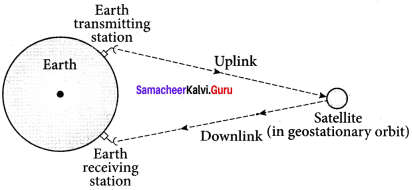
The high-frequency radio wave signals travel in a straight line (line of sight) may come across tall buildings or mountains or even encounter the curvature of the earth. A communication satellite relays and amplifies such radio signals via transponder to reach distant and far off places using uplinks and downlinks. It is also called as a radio repeater in sky. The applications are found to be in all fields and are discussed below.
Applications:
Satellites are classified into different types based on their applications. Some satellites are discussed below.
- Weather Satellites:
They are used to monitor the weather and climate of Earth. By measuring cloud mass, these satellites enable us to predict rain and dangerous storms like hurricanes, cyclones etc. - Communication satellites:
They are used to transmit television, radio, internet signals etc. Multiple satellitesare used for long distances. - Navigation satellites:
These are employed to determine the geographic location of ships, aircrafts or any other object.
![]()
Question 2.
Explain the mobile communication? Write its applications.
Answer:
Mobile communication is used to communicate with others in different locations without the use of any physical connection like wires or cables. It allows the transmission over a wide range of area without the use of the physical link. It enables the people to communicate with each other regardless of a particular location like office, house, etc. It also provides communication access to remote areas.
It provides the facility of roaming:
that is. the user may move from one place to another without the need of compromising on the communication. The maintenance and cost of installation of this communication network are also cheap.
Applications:
- It is used for personal communication and cellular phones offer voice and data connectivity with high speed.
- Transmission of news across the globe is done within a few seconds.
- Using Internet of Things (IoT), it is made possible to control various devices from a single device.
Example: home automation using a mobile phone. - It enables smart classrooms, online availability of notes, monitoring student activities etc. in the field of education.
Question 3.
What do you know about INTERNET? Write its few applications?
Answer:
Internet is a fast growing technology in the field of communication system with multifaceted tools. It provides new ways and means to interact and connect with people. Internet is the largest computer network recognized globally that connects millions of people through computers. It finds extensive applications in all walks of life.
Applications:
- Search engine:
The search engine is basically a web-based service tool used to search for information on World Wide Web. - Communication:
It helps millions of people to connect with the use of social networking: emails, instant messaging services and social networking tools. - E-Commerce:
Buying and selling of goods and services, transfer of funds are done over an electronic network.
Samacheer Kalvi 12th Physics Communication Systems Additional problems
Question 1.
A radio can tune to any station in 7.5 MHz to 12 MHz band. What is the corresponding wavelength band?
Solution:
Frequency of 7.5 MHz belongs to SW band. The corresponding wavelength is
λ = \(\frac { c }{ υ }\) = \(\frac { 3\times { 10 }^{ 8 } }{ 7.5\times { 10 }^{ 6 } } \) = 40m
Frequency of 12 MHz belongs to HF band, the corresponding wavelength is
λ = \(\frac { c }{ υ }\) = \(\frac { 3\times { 10 }^{ 8 } }{ 12\times { 10 }^{ 6 } } \) = 25m
Corresponding to the given frequency band, the wavelength band is 25 m – 40 m band.
Question 2.
A TV transmitting antenna is 125 m tall. How much service area can this transmitting antenna cover, if the receiving antenna is at the ground level? Radius of earth = 6400 km.
Solution:
hT = 125 m and R = 6400 x 103 m
d = \(\sqrt { 2{ h }_{ T }R } \) = \(\sqrt { 2{ h }_{ T }R } \) = 40 x 103m = 40 km
Area covered A = πd2 = 3.14 x (40)2 = 5024 km2
![]()
Question 3.
A transmitting antenna at the top of a tower has a height 32 m and that of the receiving antenna is 100 m. What is the maximum distance between them for satisfactory communication in LOS mode? Given radius of earth 6.4 x 106 m.
Solution:
hT = 32 m, hR = 100 m
R = 6.4 x 106 m
dm = \(\sqrt { 2R{ h }_{ T } } \) = \(\sqrt { 2R{ h }_{ R } } \)
= \(\sqrt { 2\times 604\times { 10 }^{ 6 }\times 32 } \) + \(\sqrt { 2\times 604\times { 10 }^{ 6 }\times 100 } \)
= (64 x 102√10) + 98 x 103√10) = 144 x 102√10 machines
dm = 45. 5 km